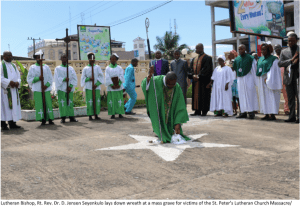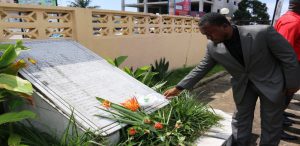Monrovia – It has been 28 years since the St. Peter’s Lutheran Church Massacre. Survivors, most of whom only escaped death through the sacrifice of loved ones, have yet to see justice.
This story first appeared on FrontPageAfricaOnline as part of a collaboration for the West Africa Justice Reporting Project.

Peterson Sonyah, 43, was only fifteen when his father was killed, one of an estimated 600 who died that night. He still recalls the event as if it happened yesterday. Sonyah’s father shielded his son’s body as they lay under a pew near the front of the church and took the bullets for him to live.
“When I think about what my father did for me, I feel sad, because he showed to me that even if he died, I should live. He sacrificed his life for me,” said Sonyah. As he lead a group of journalists on a recent tour of the now-rehabilitated church Sonyah said that his family was lucky that his mother and two younger siblings, sleeping with women and children in the school, were unharmed.
Sonyah is one of hundreds of survivors of the massacre who have been fighting for justice for themselves and their loved ones. Noone has been charged with any crimes inside Liberia from Liberia’s civil war but the Center for Justice and Accountability brought a civil suit against Moses Thomas, now living in Philadelphia, in the US earlier this year, on behalf of four of the victims of the Lutheran Church Massacre.
The victims’ identities have been withheld for their security. Thomas is alleged to have given the command for the massacre by troops from the government of Samuel Doe. Thomas will be asked to pay damages to the victims if found guilty. He is fighting the case.
But the Lutheran Church survivors are doing another battle. The dead from the massacre are buried in mass graves around the church compound. Large white stars painted on the carpark at the front of the church mark the spots where many bodies were buried. Today children play on a basketball court that has been built over one of the graves.
“Whenever I see children playing basketball on top of the mass grave that could be holding my father’s body, it hurts me, because it is like they are rejoicing over the death of people who died painfully in this church,” said Sonyah.
Traditional Liberian culture demands respect for the dead. To not even have a suitable grave is a great shame to family. At a recent gathering of 62 Lutheran survivors Sonyah said all expressed their distress at the disrespect with which their loved ones remains are being treated.
“We were always told by our old people, that it is not good to point at a grave or your finger would get rotten, so we were always afraid. I have been telling the pastors about the situation but they are not doing anything to stop it,” said Sonyah.

Kenety S. Gee the Assistant Pastor of the Lutheran Church, told reporters he knows survivors are hurt by the mass graves. Church leaders are discussing the building of a memorial at the church in memory of the survivors. He would like to see it go further. Amazingly children in the church’s school do not learn about the massacre that happened on the ground on which they walk every day. He thinks a memorial at Lutheran and at other massacre sites will help the nation learn from the events of the war.
“I cannot speak on the massacre not being taught in the school because I am new here, but I think the massacre should be written as our history and taught to the younger generation because many of the kids were not born during our civil war,” said Rev. Gee.
Gee said the memorial discussion has been going on for the last seven years, but the church has been waiting for outside groups responsible for erecting memorials. As nothing has materialized this year the church has decided to take the lead.
“What I think, is that the churches build a memorial and sensitize the entire nation, because history is a powerful tool. When this done, it will remind people of what took place in the past,” said Rev. Gee.
Gee is also mindful of the suffering of the Lutheran Church survivors, particularly after July’s anniversary commemoration. Many have physical and mental wounds that have impacted their whole lives, he said.
“Some of these survivors are still living with bullets inside them, so we should care for them because it is a daily struggle for them. Many still do not come to the church because it brings back bad memories, but we need to figure out a way to help them to improve their lives,” said Rev. Gee.
The Independent National Commission on Human Rights is the overall institution responsible for erecting monuments or memorials in Liberia. It is now erecting a monument in Bomi County for the massacre that took place on the Maher Bridge in 2002. Commissioner James Torh said there is no money for a memorial at the Lutheran Church.
“Building monuments requires resources. We want to do other monuments but this government has not committed itself to give us funding to build those monuments,” said Torh.
The monument at Du-port Road waterside was funded by the UNDP. The government of of Ellen Johnson Sirleaf paid for the monument at the Maher Bridge.
Speaking about respecting the dead, Torh who was smiling, said as a child growing up in the interior, he too was punished for pointing at the dead, as it was a taboo to do in those days.
“When I was little in the interior, I too was warned and punished by my older brother not to ever point my finger at a grave or a grave yard or my hand would have remained stuck in one place. The situation is painful to accept for people to see their loved ones being disrespected. I think what we need to do as a people, is to respect the dead as it is historical.”
He said they are engaging donors to build a monument at the Lutheran Church, but insisted such fundraising takes time. Torh said the commission intends to visit the church to see how they can work together, even without resources to see that a monument is built.
